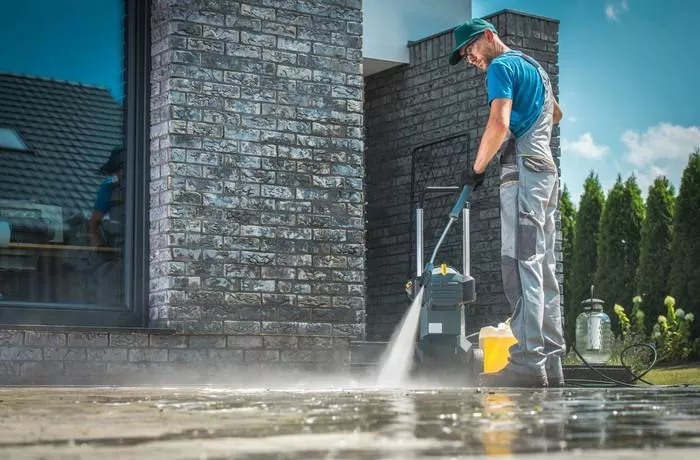Cleaning concrete surfaces requires more than just water and elbow grease. To effectively remove dirt, grime, and stains, you need the right tools and techniques. One crucial factor in achieving a clean concrete surface is the pressure applied during cleaning, measured in pounds per square inch (PSI). In this article, we’ll delve into the world of PSI and explore whether 3000 PSI is sufficient for cleaning concrete, along with valuable insights into pressure washer selection, safety precautions, environmental considerations, and maintenance tips.
Explanation of PSI
PSI, or Pounds per Square Inch, is a unit of pressure measurement commonly used to quantify the force exerted by a fluid (in this case, water) on a surface area. In concrete cleaning, PSI refers to the pressure at which water is expelled from a pressure washer nozzle onto the concrete surface. The higher the PSI, the greater the force applied, which translates to more effective cleaning power.
Effectiveness of 3000 PSI
A pressure of 3000 PSI is widely considered suitable for cleaning most concrete surfaces. Concrete is a durable material, but it can accumulate various types of debris, including dirt, grime, oil stains, mold, and mildew. A pressure of 3000 PSI provides sufficient force to dislodge and remove these contaminants without causing damage to the concrete surface itself.
Comparatively, lower PSI levels may not deliver enough force to effectively clean stubborn stains and dirt buildup on concrete. On the other hand, excessively high PSI levels, such as those exceeding 3000 PSI, can pose a risk of surface damage, including etching or gouging the concrete. Therefore, 3000 PSI strikes a balance between cleaning effectiveness and preserving the integrity of the concrete surface.
Types of Concrete Cleaning
The suitability of 3000 PSI for concrete cleaning depends on the specific scenario. Here’s a breakdown of different cleaning scenarios:
1. General Dirt and Grime: For routine cleaning of dirt and grime on concrete driveways, sidewalks, and patios, 3000 PSI is typically sufficient to achieve satisfactory results.
2. Oil and Grease Stains: Removing oil and grease stains from concrete may require additional cleaning agents or pre-treatment, but a pressure washer operating at 3000 PSI can effectively lift and disperse these stubborn stains.
3. Mold and Mildew: In areas prone to mold and mildew growth, higher PSI levels may be necessary to penetrate and remove these organic contaminants thoroughly. However, 3000 PSI can still be effective when combined with appropriate cleaning solutions.
Pressure Washer Recommendations
When selecting a pressure washer for cleaning concrete, consider factors such as power source, portability, and PSI level. Here are some recommendations:
1. Electric Pressure Washers: Electric pressure washers are suitable for small to medium-sized concrete cleaning tasks. They are lightweight, easy to maneuver, and emit less noise compared to gas-powered models. Look for electric pressure washers with a PSI rating of at least 2000 to 3000 for effective concrete cleaning.
2. Gas-Powered Pressure Washers: Gas-powered pressure washers offer greater mobility and higher PSI ratings, making them ideal for larger concrete surfaces or areas without easy access to electricity. Opt for gas-powered models with PSI levels ranging from 3000 to 4000 for optimal cleaning performance.
Safety Tips
Using a high-pressure washer requires caution to prevent injuries and damage. Follow these safety precautions:
1. Wear Protective Gear: Always wear protective eyewear and gloves to shield yourself from debris and high-pressure spray.
2. Maintain Distance: Keep a safe distance between the pressure washer nozzle and the concrete surface to avoid causing damage or injury.
3. Use Proper Techniques: Direct the spray nozzle at a downward angle to prevent water from seeping underneath the concrete surface.
4. Avoid High Pressure on Joints: Be cautious around expansion joints and cracks in the concrete to prevent further damage.
Additional Cleaning Tips
To enhance the effectiveness of concrete cleaning, consider the following tips:
1. Choose the Right Cleaning Agent: Use specialized concrete cleaners or detergents designed to break down stains and grime effectively.
2. Clean During Ideal Conditions: Optimal cleaning conditions include mild temperatures, low wind, and moderate humidity. Avoid cleaning during extreme heat or cold, as it may affect cleaning efficiency.
3. Time Your Cleaning: Perform concrete cleaning during daylight hours to ensure proper visibility and avoid shadows that may obscure dirt and stains.
4. Test in a Small Area: Before tackling large concrete surfaces, test the pressure washer and cleaning agent in a small, inconspicuous area to assess its effectiveness and compatibility with the surface.
Maintenance Advice
Proper maintenance is essential for prolonging the lifespan of both the concrete surface and the pressure washer. Follow these maintenance tips:
1. Clean Regularly: Remove debris and dirt buildup from the pressure washer nozzle, wand, and hoses after each use to prevent clogs and maintain optimal performance.
2. Inspect Concrete Surface: Periodically inspect the concrete surface for cracks, chips, or signs of deterioration. Promptly repair any damage to prevent further deterioration.
3. Winterize Pressure Washer: If you live in a region with cold winters, properly winterize your pressure washer to prevent freezing and damage to internal components.
Environmental Considerations
While pressure washing is an effective cleaning method, it’s important to consider its environmental impact and take steps to minimize harm:
1. Water Conservation: Use water-efficient pressure washers and avoid excessive water usage by using targeted spraying techniques.
2. Eco-Friendly Cleaning Agents: Choose biodegradable and environmentally friendly cleaning agents to minimize pollution and harm to aquatic ecosystems.
3. Proper Disposal of Wastewater: Dispose of wastewater properly to prevent contamination of storm drains and water bodies. Consider using containment mats or barriers to collect and contain runoff during cleaning.
Conclusion
In conclusion, a pressure of 3000 PSI is generally sufficient for cleaning most concrete surfaces, providing effective removal of dirt, grime, and stains while minimizing the risk of surface damage. By following safety precautions, selecting the right pressure washer, employing proper cleaning techniques, and prioritizing environmental considerations, you can achieve clean concrete surfaces without compromising safety or sustainability.

